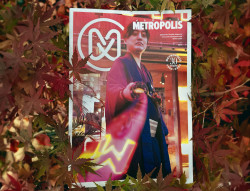
Originally published on metropolis.co.jp on June 2011

Photos courtesy of Kelly Burton
 There was no mistaking Kelly Burton for someone else when I looked for her in a crowded Nakameguro cafe. She was the Canadian woman in kimono—today a double-lined one of cornflower blue. This is pretty much how Burton dresses every day. At least since January 1, when she started a project called “The Year in Kimono.”
There was no mistaking Kelly Burton for someone else when I looked for her in a crowded Nakameguro cafe. She was the Canadian woman in kimono—today a double-lined one of cornflower blue. This is pretty much how Burton dresses every day. At least since January 1, when she started a project called “The Year in Kimono.”
For 2011, Burton has pledged to trade her jeans and motorcycle boots, and all of the sartorial possibilities of her extensive wardrobe, for the traditional kimono, of which she has just four. Ambitious (and maybe crazy), but not without a point: “A kimono is just one piece of fabric, so there is no waste,” explains Burton, who runs an eco-fashion website called Magnifeco (www.magnifeco.com). Passed on for generations or resold at flea markets, the kimono is also sustainable, she says, adding: “It’s the perfect example of slow fashion.”
Burton, who first came to Tokyo in 2007, credits a friend with the idea. She slept on it for a few days and then decided to go for it—never mind that she’d never put on a kimono before. So at the end of December the Toronto native, who describes herself as “not a Japanophile at all,” enrolled in a six-month course at a kimono school. At the end, not only was she able to tie her own obi in a number of different styles, but she also had the mannerisms down pat. The latter is just as important, Burton explains: “I don’t want people to think I’m doing a parody.”
Sitting demurely to the side with her hands resting lightly on her sash, she looks as natural as silk. A woman sitting next to us nods with a smile and a “kirei desu ne” (“how beautiful”).
Anyone who has ever fumbled with so much as a yukata can only imagine how daunting a kimono must be. Burton describes her first attempts as “like Ikea without the directions—I had pieces left over.” She adds, “In the beginning it took me about an hour and twenty minutes to get dressed, but now I can get ready in about twenty minutes.”
Her teachers can do it in five. The art of wearing a kimono is full of quick and ingenious fixes, Burton has learned, like using your finger to measure the gap between your inner and outer robe (no need for a mirror!) and using double-sided sticky tape to attach the stiff collar (no need for needle and thread!). “It’s a bit behind the curtain,” she says. “Every kimono school or teacher has their own bag of tricks.” Though perfectionists, her teachers, one of whom speaks English, are patient and encouraging, she says. “It parallels my other experiences in Japan. If you’re interested and you’re open, people will take you in and show you.”
Before even starting, however, there was the task of finding an affordable kimono long enough in the sleeve. The secondhand kimono circuit (often dealing in third- or fourth-hand kimono) obviously favors those of shorter stature. Department store Daimaru had but one to fit her 172cm frame at its year-end kimono bazaar.
Then came the challenge of tweaking her perception of the perfect figure, perhaps the most difficult challenge of all. “From a Western perspective we’re used to having an hourglass shape and in kimono you’re supposed to be just a barrel—[which means] padding yourself out and padding yourself down and trying to change your shape,” says Burton. Indeed, she wears padding around her waist to erase her curves. “The benefit is that it is really comfortable. When my obi is tied my posture is better. I feel really contained and supported.”
Four months into the project, Burton is unwavering and upbeat: “I’m really excited because yukata season is about to start.”
Follow The Year in Kimono at www.theyearinkimono.com
Address book
- Study kimono at Hakubi Gakuin, which has branches all over Tokyo: www.hakubi.net/en
- Shop for secondhand kimono at the Sugumiya stall, Oedo Antique Market: Tokyo International Forum, 3-5-1 Marunouchi, Chiyoda-ku. Tel: 03-5444-2157. Open 1st & 3rd Sun, 9am-4pm. Nearest stn: Yurakucho. www.antique-market.jp/eng
- Pick up larger than usual geta and zori at Getaya. 1-21-8 Asakusa, Taito-ku. Tel: 03-3844-1321. Open daily 10am-7pm. Nearest stn: Asakusa. www.getaya.jp







